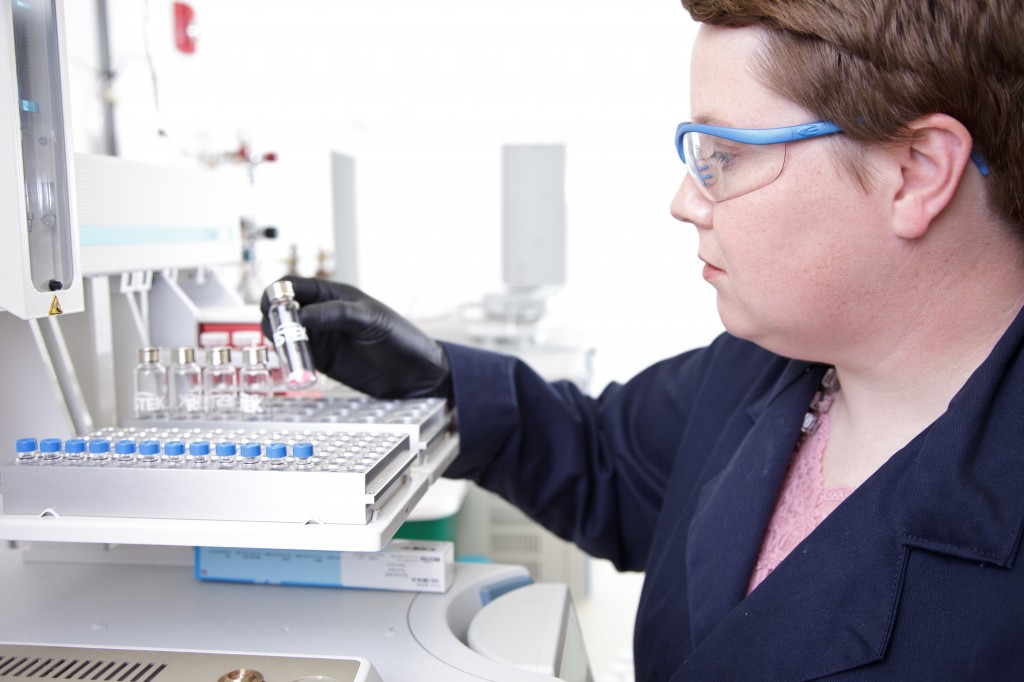
Gas chromatography (GC) is a very popular chromatography technique used to separate volatile compounds or substances that can be vaporized without decomposition. Alternative names for gas chromatography are gas-liquid chromatography and vapor-phase chromatography. In GC, the mobile phase is a gas (such as helium or nitrogen), which carries the vapors of the compound through a column with the stationary phase (a thin layer of liquid or polymer on a solid support). Typical GC columns are long, often capillary-thin and coiled to preserve space. The vapors of the substance interact with the stationary phase, with each component exiting the column at a different time (called retention time) and detected separately.
The separation efficiency is determined by the properties of the column, such as the chemistry and the polarity of the stationary phase, the column geometry, and the temperature. The individual compounds exiting the column can be detected by a variety of devices, such as a flame ionization detector, a thermal conductivity detector, an infrared detector, and others. Very sensitive separation and detection is achieved by coupling GC with Mass Spectrometry for detection, resulting in Gas Chromatography-Mass Spectrometry (GC-MS).
Wide Range of Applications
GC-MS is a method of choice for forensics applications and is also popular for drug detection, environmental analysis, chemical analysis, food analysis, biochemical and medical characterization, anti-doping control, explosives detection, and for the identification of unknown substances. A visual representation of GC-MS using an example of separation of neutral and acidic drugs is presented in a short video by Thermo Scientifiic:
Food Analysis
Let’s take a closer look at one of the popular applications of gas chromatography. GC has been used for food analysis along with HPLC since the 1950s. One can determine food composition, additives and contaminants, as well as transformation products in food using GC-MS. The method offers rapid analysis of pesticides, antibiotics, growth hormones, bacterial toxins, chemical preservatives, synthetic antioxidants, dyes, emulsifiers, sweeteners, packaging components, and environmental pollutants in food and beverage. Industrial food processing, such as thermal processing, drying, and smoking leave unique markers identifiable by GC-MS, as does unintended spoilage.
Due to GC-MS sensitivity, it is also possible to detect minor changes in a human body related to metabolized food. For example, a recent study performed in New Zealand analyzed the connection of dairy fat intake to the presence of fatty acids in blood. Both milk products and human plasma were analyzed by GC-MS, and 25 fatty acids (four trans-fats, 11 saturated fats, six polyunsaturated fats, and four monounsaturated fats) were detected. While saturated fats and trans fatty acids are considered harmful for cardiovascular health, unsaturated, short and medium chain saturated fatty acids thought to be beneficial for the heart.
In a study, 180 volunteers consumed dairy products, and the fatty acids in their blood plasma were measured in the beginning and the end of one month. Increasing consumption by three servings per day resulted in small increase in the levels of 3 of 20 monitored fatty acids in plasma, while decreasing dairy consumption had no statistically significant effect on the plasma’s fatty acid profile. The authors concluded that dietary advice to change dairy food has a minor effect on plasma fatty acid levels, an unexpected result for our compulsively dieting population … all due to GC-MS!
Source: “Application of Gas Chromatography in Food Analysis” (pdf), by S. Lehotay and J. Hajslova. Trends in Analytical Chemistry, 21(9-10): 686-697, 2002.
Source: “The Effects of Changing Dairy Intake on Trans and Saturated Fatty Acid Levels-Results From a Randomized Controlled Study,” by J.R. Benatar and R.A. Stewart, Nutrition Journal, April 3, 2014; 13(1):32. doi: 10.1186/1475-2891-13-32.
Source: “How GC Columns Work,” by chromatographyvideos, YouTube.
